Fermented fish
Fermented fish is a traditional preparation of fish. Before refrigeration, canning and other modern preservation techniques became available, fermenting was an important preservation method. Fish rapidly spoils, or goes rotten, unless some method is applied to stop the bacteria that produce the spoilage. Fermentation is a method which attacks the ability of microbials to spoil fish. It does this by making the fish muscle more acidic; bacteria usually cease multiplying when the pH drops below 4.5.
A modern approach, biopreservation, adds lactic acid bacteria to the fish to be fermented. This produces active antimicrobials such as lactic and acetic acid, hydrogen peroxide, and peptide bacteriocins. It can also produce the antimicrobial nisin, a particularly effective preservative.[1][2]
Fermented fish preparations can be notable for their putrid smell. These days there are many other techniques of preserving fish, but fish is still fermented because some people enjoy the taste.
Risks
Alaska has witnessed a steady increase of cases of botulism since 1985.[3] It has more cases of botulism than any other state in the United States of America. This is caused by the traditional Eskimo practice of allowing animal products such as whole fish, fish heads, walrus, sea lion, and whale flippers, beaver tails, seal oil, birds, etc., to ferment for an extended period of time before being consumed. The risk is exacerbated when a plastic container is used for this purpose instead of the old-fashioned, traditional method, a grass-lined hole, as the botulinum bacteria thrive in the anaerobic conditions created by the air-tight enclosure in plastic.[3]
Preparations
| Name | Image | Origin | Description |
|---|---|---|---|
| Anchovies, anchoa |  |
Mediterranean, Argentina, Uruguay, Brazil, Peru | The name "anchovies" is used for fresh/frozen anchovies and also for salt-cured Mediterranean anchovies Engraulis encrasicolus. The latter are produced from headed, salted, pressed anchovies that have ripened for at least 6 months. The fish is then filleted and packed in oil, or it is packed in salt without filleting, the filleting to be done by the customer.
In South America a similar product, called anchoa, is made from other anchovy species, anchovita (Engraulis anchoita) in Argentina/Uruguay/Brazil and anchoveta (Engraulis ringens) in Peru. |
| Bagoong | |
Filipino | Partially or completely fermented fish or shrimps.[4] Fish bagoong is prepared by mixing salt with fish,[5] and placing it inside large earthen fermentation jars.[6] There it is left to ferment for 30–90 days with occasional stirring to make sure the salt is spread evenly.[7] A food colouring called angkak is added to give the bagoong its characteristic red or pink colour. Angkak is made from rice inoculated with a species of red mold (Monascus purpureus).[5] Some manufacturers grind the fermented product finely and sell the resulting mixture as fish paste.[8] A byproduct of the fermentation process is a fish sauce called patis.[9] |
| Bottarga, poutargue, boutargue, botarga | 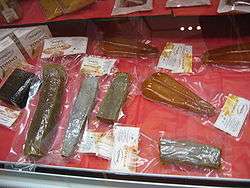 |
Mediterranean, Mauritania | Bottarga is salted cured fish roe, typically of grey mullet frequently found near coastlines throughout the world. |
| Chêpa Shũṭki | Bengal, Bangladesh | Literally "pressurized shũṭki" or "pressurized dried fish". Fish or shrimp are sun-dried for 12 to 14 days, then kept in a jute sack for one month, after which it is washed and placed in a pressurized earthenware pot for 3 to 4 months. | |
| Colombo cure | Sri Lanka, India, Bangladesh | Fish are gutted, washed and salted together with dried fruit pulp or tamarind. The fish are kept covered in brine with the help of weighted mats and are fermented for 2 to 4 months. | |
| Fesikh, fassikh, fassiekh, terkeen | |
Egypt, Sudan | Fermented, salted and dried gray mullet, of the mugil family, a saltwater fish that lives in both the Mediterranean and the Red Seas.[10] The traditional process of preparing it is to dry the fish in the sun before preserving it in salt. The process of preparing fesikh is quite elaborate, passing from father to son in certain families. The occupation has a special name in Egypt, fasakhani. Fesikh is eaten during the Sham el-Nessim festival, which is a spring celebration from ancient times in Egypt.
In Sudan species used are Alestes spp. and Hydrocynus spp. Processing time is 10 to 20 days. The products is packed in wooden boxes and also in used vegetable oil tins. In the case of terkeen the fermented fish is warmed up and stirred at the end of the processing period, resulting in a paste that includes small fish bones and has a taste resembling both liver pâté and anchovy paste. Both products are important ingredients (condiments) in Sudanese as well as in Egyptian cooking. |
| Fish sauce |  |
Asia | Clear light or dark brown liquid produced from salted fermented anchovies (Stolephorus sp.) or other fish or fishery products such as squid, shrimp and shellfish. The fermentation period is usually half a year or more, up to one and a half year (the longer the better). Local names are: Cambodia - nuoc mam; China - yu lu, xing tang, yee su; Indonesia - ketjap ikan; Japan - ishiri, ishiru, shotssuru, ikanago; Korea - aekjeot; Lao - nam pla; Malaysia - budu; Myanmar - ngapi; Philippines - patis; Thailand - nam pla; Vietnam - nuoc mam.
A similar product produced in Italy is colatura di alici. Attempts to make similar products in Africa (Côte d'Ivoire, Madagascar, Senegal) failed because of lack of involvement of the private sector, but the potential still exists. Also in South America there is potential to make it, for instance in Peru from longnose anchovy Anchoa nasus. |
| Garum | |
Ancient Roman | Fermented fish sauce and essential flavour |
| Guedj |  |
Senegal | Salt-cured fish popular as flavoring in local dishes in Senegal and West Africa. Gutted whole or split fish are packed between layers of coarse sea salt and fermented for one to three days. They are then sun-dried. |
| Hákarl | |
Iceland | Consists of a Greenland- or basking shark cured and hung to dry for four to five months. Hákarl is often referred to as an acquired taste[11] and smells richly of ammonia with a strong fish and cheese taste. Traditionally prepared by gutting and beheading the shark and burying it in a shallow hole in gravelly sand. Stones are placed on top to press fluids from the shark. The shark ferments this way for 6–12 weeks, and is then cut into strips and hung to dry for several months. During the drying period a brown crust develops, which is removed prior to cutting the shark into small pieces and serving. The modern method is just to press the shark in a large drained plastic container. Chef Anthony Bourdain described hákarl as "the single worst, most disgusting and terrible tasting thing" he has ever eaten.[11] Chef Gordon Ramsay challenged journalist James May to sample hákarl on The F Word. Ramsay vomited after the experience.[12] |
| Hongeohoe |  |
Korea | Made from fermented skate. Has a strong characteristic ammonia-like odour. Usually served uncooked and without further preparation, along with other Korean side dishes such as kimchi. |
| Kusaya | |
Japan | Salted-dried and fermented fish, famous for its malodorousness similar to the pungent fermented Swedish herring surströmming. Though the smell of kusaya is strong, the taste is quite mellow. Often eaten with Japanese sake or shōchū. Kusaya originated in the Izu Islands, probably on Niijima, where, during the Edo period people used to earn a living through salt making. Villagers paid taxes to the government with the salt they made, and as taxes were high, salt for fish-curing was used frugally. The same salt was used many times for this purpose, resulting in a pungent dried fish, which was later called kusaya. The resulting, tea-colored, sticky, stinky brine was passed on from generation to generation as a family heirloom. Though kusaya is made on several of the Izu Islands today, it is said that kusaya from Niijima has the strongest odor. |
| Lakerda | Greek | ||
| Lanhouin | Ghana, Togo, Benin | Lanhouin is salted fermented dried fish produced in the coastal regions of the Gulf of Benin using croaker (Cassava fish, Pseudotholithus sp.) or West African Spanish mackerel (Scomberomorus tritor). Lanhouin is widely used as a condiment. | |
| Mahyaveh | Iran | Mahyaveh is produced in the southern part of Iran, especially in Larestan and Hormozgan, from sardines (Sardinella sp.) or anchovies (Stolephorus sp.), salt, spices and water. The fish - fresh or dried - are headed, washed, mixed with salt and warm water and packed into earthenware or glass jars. After a month the mixture is mashed into a slurry and filtered. The resulting brown liquid is then mixed with mustard (Brassica juncea) and other spices, such as cumin (Cuminum cyminum), coriander (Coriandrum sativum), fennel seeds (Foeniculum vulgare), black pepper (Piper nigrum) and thyme (Thymus capitatus). After another 10 to 15 days the desirable taste and aroma are produced and the sauce is ready. | |
| Matjes (maatjes) herring | 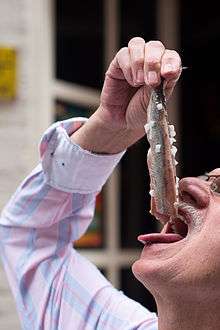 |
Netherlands | Lightly salted and fermented fat young herring usually eaten with chopped onion. The name derives from the Dutch "maagd" (virgin) as the young herring have no developed gonads. See Gibbing. |
| Momone (momoni) | Ghana | Momone is produced in Ghana from various fish species and also from squid and octopus. The fish is gutted, washed, rubbed with salt and packed in layers in barrels, alternating with layers of salt. After fermentation for 7 days the fish are dried in the sun. Pieces of momone, together with ground red pepper, tomato, onion and palm oil are boiled to a sauce to accompany pounded starchy staple foods. | |
| Ngari | Manipur India |
Ngari is a traditional fermented food of Manipur. It is prepared by fermenting smaller freshwater fishes with mustard oil and salt. The dried fish are then tightly packed them in a big clay urn which is made airtight. The urn is buried for 30–40 days. Ngari is roasted lightly prior to consumption, and then added in many Manipuri dishes, such as eromba.[13][14] | |
| Pekasam | Malaysia | Fermented half/fully fried mild coarse rices made by pickling several varieties of almost all fresh water fish, mainly Anabas testudineus, Tinfoil barb, Snakehead, Catfish, Leptobarbus hoevenii sometimes in Borneo, they ferment Macrobrachium rosenbergii, Freshwater prawn farming. Slightly different recipe and process of making Pla ra, the fish is also cleaned, cut into pieces if the size is too big and preserved with salt for several days and then mix with half fried Rice bran plus palm sugar or brown sugar. The sugar is claimed as starter to the rice bran to become brewed as result the pekasam have nicer sweet sour smells and salty taste. Sometimes tamarind juice also added to make the more sour effect. This is then left(traditionally) in a clay crock covered with a cheesecloth lid, to ferment for at least a week until to a year.[15] | |
| Prahok |  |
Cambodia | Prahok is a crushed, salted and fermented fish paste (usually of mud fish) that is used in Cambodian cuisine as a seasoning or a condiment. It originated as a way of preserving fish during the longer months when fresh fish was not available in abundant supply. Because of its saltiness and strong flavor, it was used as an addition to many meals in Cambodian cuisine, such as soups. Prahok has a strong and distinct smell, earning the nickname Cambodian Cheese. Prahok is usually eaten with rice in the countryside or poorer regions. |
| Pla ra | 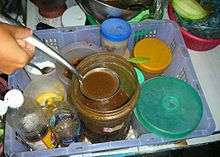 |
Thailand | Fermented fish sauce made by pickling several varieties of fish, mainly snakehead murrel. The fish is cleaned, cut into pieces and mixed with salt and rice bran. This is then left in a big jar covered with a wooden lid, to ferment for three months to a year.[16] Recently a dried powdered version of pla ra has been successfully marketed.[17] |
| Rakfisk | 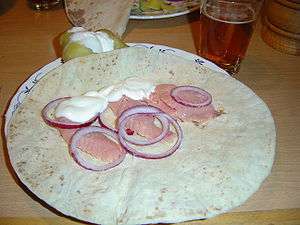 |
Norway | Made from trout or sometimes char, salted and fermented for two to three months, or even up to a year, then eaten without cooking. The first record of the term rakfisk dates back to 1348, but the history of the food is probably even older.[18] As a dish, rakfisk is related to the Swedish surströmming and possibly shares a common origin. Traditionally eaten around Christmas. |
| Surströmming |  |
Sweden | Fermented Baltic herring, notorious for its pungent odour. |
| Tepa | Yup'ik | Tepas, also called stinkheads, are fermented whitefish heads. A customary way of preparing them is to place fish heads and guts in a wooden barrel, cover it with burlap, and bury it in the ground for about a week. For a short while in modern times, plastic bags and buckets replaced the barrel. However this increased the risk of botulism, and the Yupik Eskimos have reverted to fermenting fishheads directly in the ground.[19][20] | |
| Trassi (terasi, terassi) | 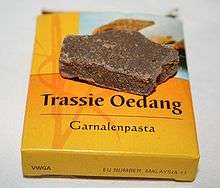 |
Indonesia, Malaysia | Dark blocks made from dried fermented salted paste from tiny shrimp (trassi udang) or small fish (trassi ikan). |
See also
Fermented fish are highly popular in Northeast states of India and Bangladesh. There are several products traditionally prepared in the region viz. Shidal or seedal- prepared from small carp (Puntius spp.) is a product of Assam and Tripua (Northeast states of India). Fish is fermented in earthen pots for about 6 months and the final product is solid with sticky surface and strong pungent smell. It is eaten after elaborate cooking and prepared dishes like vegetable mix curry or chutney, and eaten as condiment with rice or chapati. Other products are tungtap of Meghalaya, Ngari of Manipur and numsing of Assam. They are also similar products.
Notes
- ↑ Ababouch, Lahsen (2005) "Preservation techniques" FAO Fisheries and Aquaculture topics. Rome. Updated 27 May 2005.
- ↑ Alzamora, Stella; Tapia, Maria Soledad; López-Malo, Aurelio (2000). Minimally Processed Fruits and Vegetables: Fundamental aspects and applications. Springer. p. 266. ISBN 978-0-8342-1672-3.
- 1 2 "Why does Alaska have more botulism". Centers for Disease Control and Prevention (U.S. federal agency). Retrieved 18 July 2011.
- ↑ J. Dagoon (2000). Agriculture & Fishery Technology III. Rex Bookstore, Inc. pp. 242–243. ISBN 978-971-23-2822-0.
- 1 2 National Research Council (U.S.). Board on Science and Technology for International Development (1988). Fisheries technologies for developing countries: report of an ad hoc panel of the Board on Science and Technology for International Development, Office of International Affairs, National Research Council. National Academies. p. 163.
- ↑ Chris Rowthorn, Greg Bloom (2006). Lonely planet: Philippines. Lonely Planet. p. 147. ISBN 978-1-74104-289-4.
- ↑ Priscilla C. Sanchez (2008). Philippine fermented foods: principles and technology. UP Press. p. 424. ISBN 978-971-542-554-4.
- ↑ Home Economics and Livelihood Education 5. Rex Bookstore, Inc. 1990. p. 409. ISBN 978-971-23-0033-2.
- ↑ National Research Council (U.S.). Panel on the Applications of Biotechnology to Traditional Fermented Foods (1992). Applications of biotechnology to traditional fermented foods: report of an ad hoc panel of the Board on Science and Technology for International Development. National Academies. pp. 132–133.
- ↑ Baheyeldin Dynasty site
- 1 2 Herz, Rachel (28 January 2012). "You eat that?". Wall Street Journal. Retrieved 30 January 2012.
- ↑ "Gordon Ramsay vs. James May", The F-Word
- ↑ Jeyaram K, Singh TA, Romi W, Devi AR, Singh WM, Dayanidhi H, Singh WM and Tamag JP (2009) "Traditional fermented foods of Manipur" Indian Journal of Traditional Knowledge, 8 (1): 115–121.
- ↑ Thapa N, Pal J and Tamang JP (2004) "Microbial diversity in ngari, hentak and tungtap, fermented fish products of North-East India" World Journal of Microbiology & Biotechnology, 20: 599–607.
- ↑ ms:Pekasam
- ↑ Pla ra
- ↑ Powdered pla ra
- ↑ Rakfisk historie
- ↑ p. 69, Subsistence salmon fishing in Nushagak Bay, Southwest Alaska, Jody Seitz, technical paper no. 195, Alaska Department of Fish and Game, Division of Subsistence, Juneau, Alaska, December 1990. Page 68.
- ↑ p. 5, Botulism in Alaska, a guide for physicians and healthcare providers, 2005 update, State of Alaska, Department of Health & Social Services, Division of Public Health, Section of Epidemiology.
References
- Kose S and GM (2011) "Sustainability of fermented fish products" Pages 39–47. In: George Hall, Fish Processing: Sustainability and New Opportunities, John Wiley & Sons. ISBN 9781444348026.
- Steinkraus, Keith H (2004) Industrialization of Indigenous Fermented Foods CRC Press. ISBN 9780824750947.
